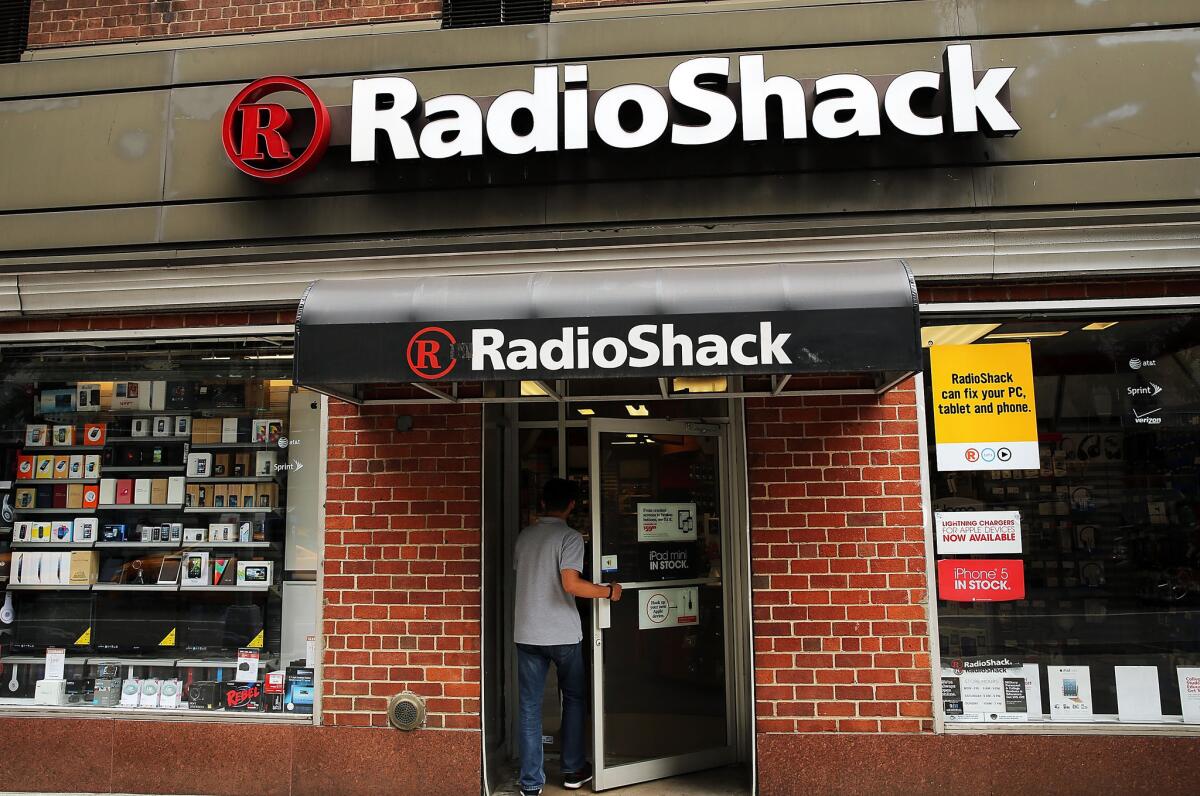A looming farewell--though not good riddance--to RadioShack

Several generations of home electronics hobbyists, ham radio enthusiasts and computer nerds spent their growth-spurt years haunting their local RadioShack stores. They can’t be happy about the company’s long slide toward irrelevance and its looming disappearance as a feature of the retail landscape.
The chain joined the quixotic rush by American retailers to open on Thanksgiving Day, but was one of the very few outside the grocery business to be open as early as 8 a.m. A surer sign of management desperation is hard to conceive--or of management cluelessness, for that matter.
The Fort Worth firm’s CEO, Joe Magnacca, characterized the policy as an effort to “capture the opportunity in the marketplace,” but it’s hard to figure where the clamor was in the wee hours of Thanksgiving Day for RadioShack’s inventory of electronic adapters, batteries and other cheap gewgaws. A few cooks preparing family dinners might have had a burning last-minute need for a spare meat thermometer, but those could only be ordered from RadioShack online, so dropping in at any of its 5,200 local stores that were open (including three of the seven within five miles of my home) wouldn’t have done them any good.
Harbingers of RadioShack’s imminent demise are everywhere. Its employees feel abused. The company has been trying to restructure its finances for months to pursue what Magnacca calls an “operational turnaround.” But its latest financial statements have been nothing short of horrific. In September, the firm announced its 10th consecutive money-losing quarter; its cash on hand had dwindled to $30.5 million from $440 million a year earlier. (We asked RadioShack for a comment on these and other issues, but haven’t heard back.)
At that time, the firm disclosed that “we may not have enough cash and working capital to fund our operations beyond the very near term, which raises substantial doubt about our ability to continue as a going concern” and mentioned the possibility of bankruptcy. Since then, its largest shareholder, the hedge fund Standard General, has given it a little more financial breathing room to show financial progress, but its forebearance could run out early next year. As I write, the stock is trading at 80 cents a share.
RadioShack’s strategic thrashing is a familiar sight to anyone who follows moribund companies. For a time it positioned itself as a go-to retailer of mobile phones, but becoming a handmaiden of big, powerful mobile companies didn’t prove to be the path to survival. Squeezed by big box retailers such as Best Buy, online merchants such as Amazon, and its brand suppliers, RadioShack seemed to disappear before our eyes. Shopping at the outlets in my neighborhood is a depressing experience, like dropping in at a 7-11 at 2 a.m. The stores are mostly dark, dingy, cramped and with a decidedly utilitarian and uncompelling inventory. I haven’t spent more than $6.99 on a RadioShack purchase in years.
It wasn’t always this way. The company’s heyday ran from the 1970s through the late 1990s, when it rode the citizens band radio craze as the largest retailer in the market, and then morphed into a creditable maker of computer gear.
RadioShack introduced its TRS-80 personal computer in August 1977. For a time the unit held the home computing market in thrall, along with the Apple II and Commodore PET 2001--aficionados nicknamed the machine the “Trash-80,” with equal parts disdain and fondness.
In 1983 came the TRS-80 Model 100/102, a pioneering laptop made out of high-impact plastic with an embedded eight-line LCD screen and a built-in modem, which retailed for as little as $800. Two years later the line was supplemented with the Model 200, which had a flip-up 16-line screen and sold for $1,000. The computers’ specifications are laughable today, of course, but you’d be hard pressed to find a journalist from that era who traveled without one; mine got hauled from one end of Africa to the other.
RadioShack was eventually run out of the computer market by the IBM PC and its clones, but remained an important factor in the retail chain; its share price peaked in late 1999 in the high $70s, then came crashing down with the rest of the tech sector and almost never looked back.
The disappearance of RadioShack won’t leave much of a void in the tech market, but it will put as many as 27,000 employees out of work. That’s never a good thing, but one would feel even sorrier for them if RadioShack didn’t have the reputation of a detestable place to work. In 2012, it ranked as America’s third worst company to work for in a widely published survey by the website 24/7 Wall Street.
Nickel-and-diming of the workforce is another artifact of a company in its death throes. Judging by this shocking account of more than three years on the job by a former RadioShack drone, the company has polished contempt for its employees to a high luster. Its Thanksgiving Day routine was telling: The company initially announced that its stores would be open from 8 a.m. to midnight; then, after employee objections, decided to close between noon and 5 p.m. so they could spend that little time with their families.
Some retail analysts think RadioShack could have emerged from the market turmoil of the last couple of decades as a leading technology merchandiser, but that’s doubtful. Keeping up with rapidly-changing markets is hard even for retailers with strong managements and a vision. RadioShack failed to pursue a consistent strategy or preserve a consistent image, so it declined into a last-gasp seller of cheap, trivial goods and not at bargain prices; who would go to RadioShack today to buy a high-end computer or TV, when there are so many other choices around, including online?
Under Magnacca the chain talks about “reinvigorating stores, revamping product assortment and repositioning the brand,” creating “concept stores” to attract customers in 100 locations and slapping new paint on 2,000 more. That’s the essence of window-dressing, and still leaves unanswered the question: What’s RadioShack for? As its creditors and investors close in, the firm has very little time left to find an answer.
Keep up to date with the Economy Hub. Follow @hiltzikm on Twitter, see our Facebook page, or email [email protected].
More to Read
Inside the business of entertainment
The Wide Shot brings you news, analysis and insights on everything from streaming wars to production — and what it all means for the future.
You may occasionally receive promotional content from the Los Angeles Times.










